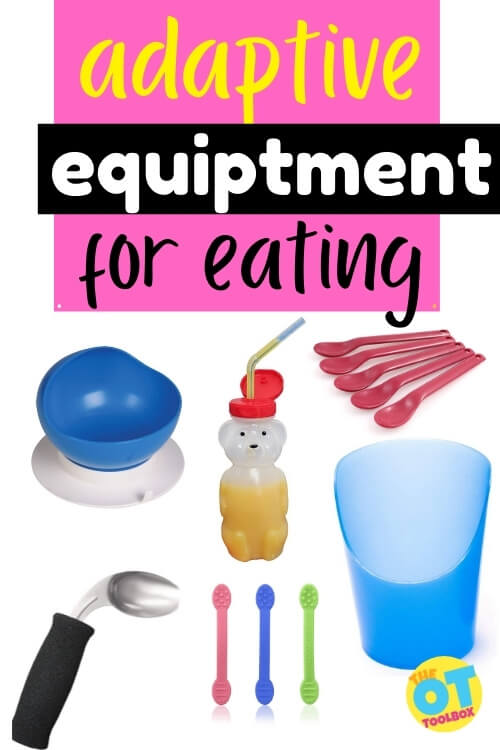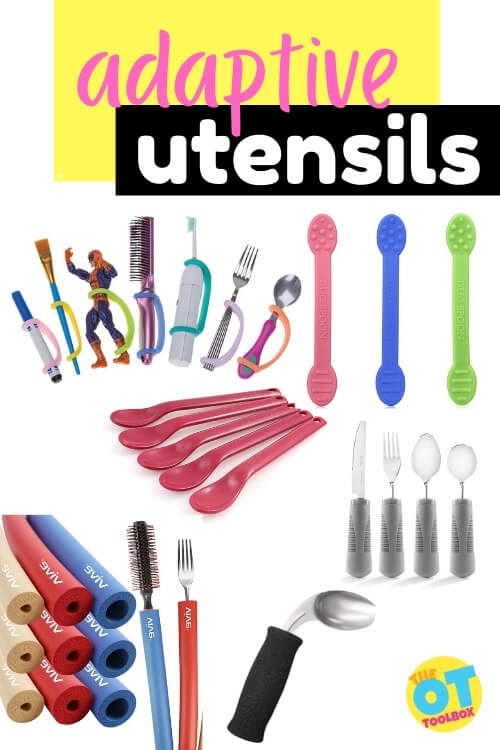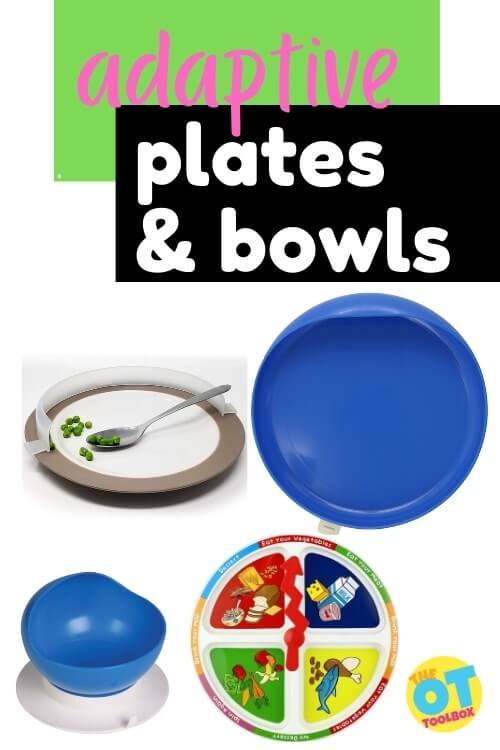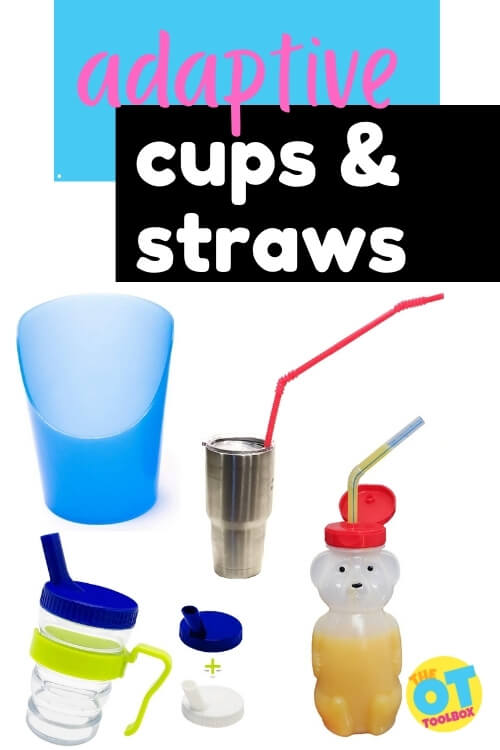Adaptive Equipment for Feeding and Eating
This article covers adaptive equipment for eating, including adaptive feeding equipment, assistive feeding devices, adaptive utensils, plates, bowls, and other tools to support functional feeding skills.
One of the main paths that occupational therapists help people achieve success in their daily occupations is through adaptive equipment and technology. There are so many great feeding products and eating tools available to increase independence, and today we will start off the conversation by introducing adaptive equipment specifically for feeding.

A great place to start with learning more about adaptive equipment for eating and the possible need for reaching out to occupational therapy for adaptive eating tools or support is this resource on Pediatric Feeding: Is it Sensory, Oral Motor, or Both?
Adaptive Equipment for Eating
When it comes to helping individuals become more independent with daily occupations, feeding and eating skills have a big role. Occupational therapy, being the holistic profession that it is, recognizes the overall piece of eating has on wellness and wellbeing, nutrition, and day to day functioning. OTs focus on both the feeding aspect for nutritional intake as well as functional eating skills in use of utensils, cups, and bowls for independence.
Let's take a look at various adaptive equipment tools for feeding and eating:

Adaptive Utensils
Adaptive dinnerware includes adjusting handles on eating utensils, adding width to the utensil handle, adding weight or length, and addressing the ability to hold a spoon, fork, or knife. Other adaptive feeding needs cover difficulty bringing food to the mouth or the ability to remove food from the utensil as a result of oral motor issues.
Let's take a look at various adaptive utensils.
Amazon affiliate links are included below.
EazyHold Silicone Silicone Aide-Basically a silicone universal cuff, this adaptive utensil tool is perfect for feeding! The silicone texture makes it easy to clean, and it comes in sizes for newborns through adults. This piece of equipment can be placed around the hand and hold common objects like forks, spoons, markers, and paintbrushes making it a one-stop device for turning household spoons, knives, and forks into adaptive eating utensils. It can remarkably increase independence for individuals that demonstrate deficits in grip strength.
Maroon Spoon– This adaptive feeding utensil is a classic! The maroon spoon has a shallow spoon depth that can assist in feeding for users with poor lip closure, oral hypersensitivity, or tongue thrust.
Weighted, Thick Handled Utensils– These weighted utensils have thick handles that are great for those who can grasp a wide handle but have a harder time holding on to something smaller that requires more grip strength. If this is the case, built-up handles are a lifesaver!
You can also use Viva Foam Tubing to make any household spoon, fork, or knife handles thicker and easier to grasp. The added weight of these utensils is also great for individuals who have tremors – the extra weight helps to combat the motion of the tremor, leading to a more successful meal time.
Textured Spoons– The texture on the spoon provides oral-motor stimulation to the mouth, increasing wanted oral movement patterns and decreasing hypersensitivity. The texture can also cue the user to engage with the tastes and textures while feeding. This spoon comes with extra-long handles to make hand over hand assist a bit easier, too!
These bendable textured spoons are great for self-feeding and oral motor stimulation as they have a smaller, hand-held size and can offer different textures for gum and tongue sensory input.
Off- Set Spoon– This tool, and many other utensils like it, allow for easier self-feeding for individuals who have limited mobility. The angle of the spoon is turned toward the person, instead of being straight, so that they can bring their spoonful of food directly to their mouth without having to change the orientation of the spoon or their bodies.

Adaptive Eating Plates and Bowls
When it comes to a container to hold food, plates and bowls can look like many things. Here, you'll find recommendations for lipped plates, suction cup
Scooper Plate– A lipped plate is just one way to help individuals scoop food from the plate surface, and not onto the table. This scooper plate is a dinner plate with a lip, or a higher edge. Here is another must-have item for individuals that have trouble scooping or stabilizing their plate or bowl.
This "scooper plate" is a plate with high walls like a bowl that have been specifically designed to make it easier to scoop and pick up food items with a utensil. Even better, there is a suction cup feature at the bottom to secure it to the tabletop for more stability while scooping. You can also get the scooper bowl here.
Plate Guard– Similar to the scooper plate, these plate guards can be added to any of your existing plates to add a wall to scoop against. This reduces spills, food waste, and time spent chasing food around with a utensil. That being said, there is much to learn from messy food play.
4-Square Meal Plate– Some feeding therapy involves increasing food repertoire for picky eaters. This plate can be a great tool to help make mealtime fun and engaging for kids. For more tips on how to improve meal times for picky eaters, check out Kids Eat in Color and ABC Pediatric Therapy Network for more resources.

Adaptive Cups
Adaptive cups can help with drinking without lifting the head or chin or can help address other motor control and strength challenges. For individuals that struggle to hold a cup or sip from the edge of a cup, there are straw options as well. Below, you'll find adapted cups that are designed for those with dysphasia or aspiration precautions. Those requiring thickness needs or safety concerns with swallowing liquids should consult a professional. Read this resource on oral motor issues and feeding needs to get started.
Flexi Nosey Cup– This is a flexible drinking cup that also has a space cut out of it to fit a person's nose. This is a simple and effective way to improve the independence of those who are limited in their ability to tilt their head back while drinking. With the space cut out for the nose, there is no need to tilt their head back while using this cup. The flexibility of the cup can control the flow of the fluid as well, to promote safe swallowing.
Bear Straw Cup– This kit can help teach a child how to drink out of a straw. The design keeps the liquid near the top of the straw so that less effort is required to take a sip. This can be great for those with oral motor deficits or those just learning how to suck. The kit comes with a lip block to prevent biting on the straw or having the straw enter the throat, and encourages oral motor exercise as well!
Recessed Lid Cup– This drinking cup is designed with two handles and a recessed lid that can improve lip closure while avoiding sippy cup use. Why do we want to avoid sippy cups? Short answer: if they are used to exclusively, for too long, they can cause dental issues and speech problems. The recessed lid cup mimics drinking from an open cup without all the spillage. Plus, it improves lip closure and tongue retraction for improved oral motor function. This kind even comes with two lid options, one that is suitable for straw use, and the other for typical drinking.
Flow Control Cup– This cup helps with oral motor control, lip closure, and tongue mobility that impacts sucking from a straw and managing the flow of liquids when drinking from a cup.
Extra-Long Drinking Straw– This flexible drinking straw is extra long, addressing mobility needs that limits an individual's ability to move closer to a cup and straw that are positioned on the table surface.
If you are a therapist or another professional looking for brands to support during feeding therapy, take a look at Ark's products. They make tons of oral motor tools for desensitizing and strengthening a child's mouth to encourage the development of food repertoire and safer, more independent feeding and swallowing.
Finally, if adaptive feeding equipment is something that needs to be further adapted to meet the specific needs of an individual, don't forget the many uses that Dycem will have in addressing specific needs.

Sydney Thorson, OTR/L, is a new occupational therapist working in school-based therapy. Her
background is in Human Development and Family Studies, and she is passionate about
providing individualized and meaningful treatment for each child and their family. Sydney is also
a children's author and illustrator and is always working on new and exciting projects.
jacksonkrounist44.blogspot.com
Source: https://www.theottoolbox.com/adaptive-equipment-for-eating/
0 Response to "Adaptive Equipment for Feeding and Eating"
Post a Comment